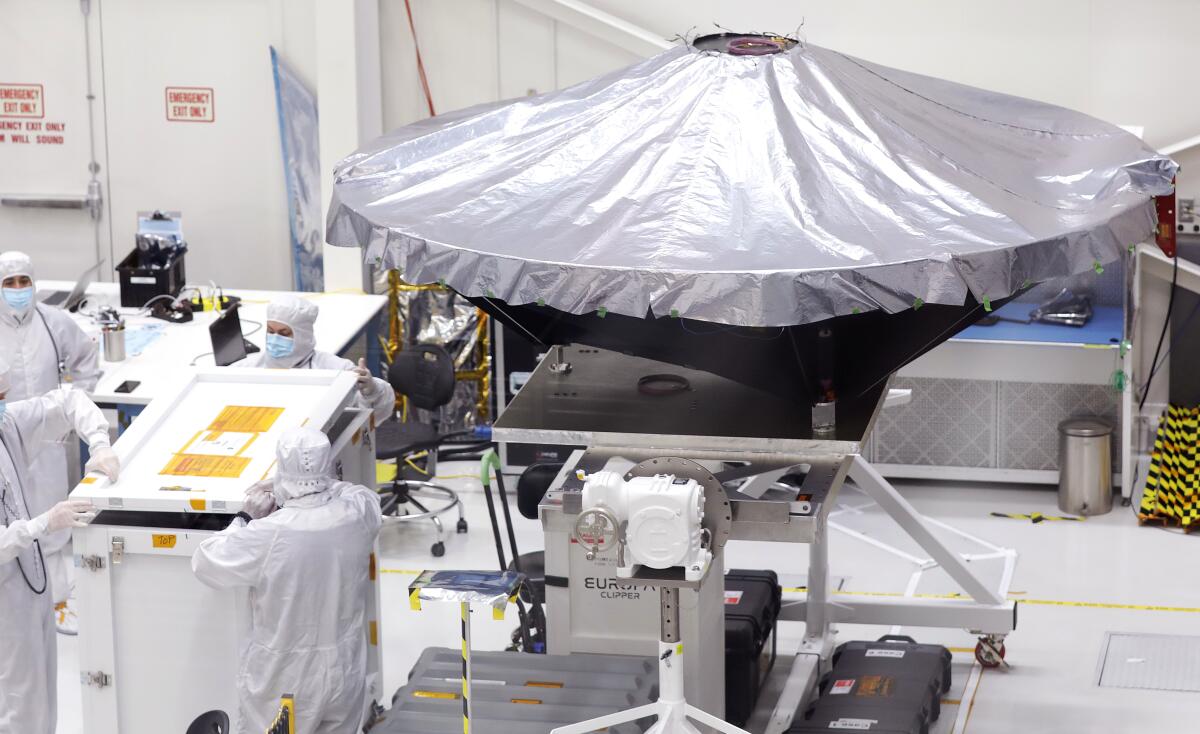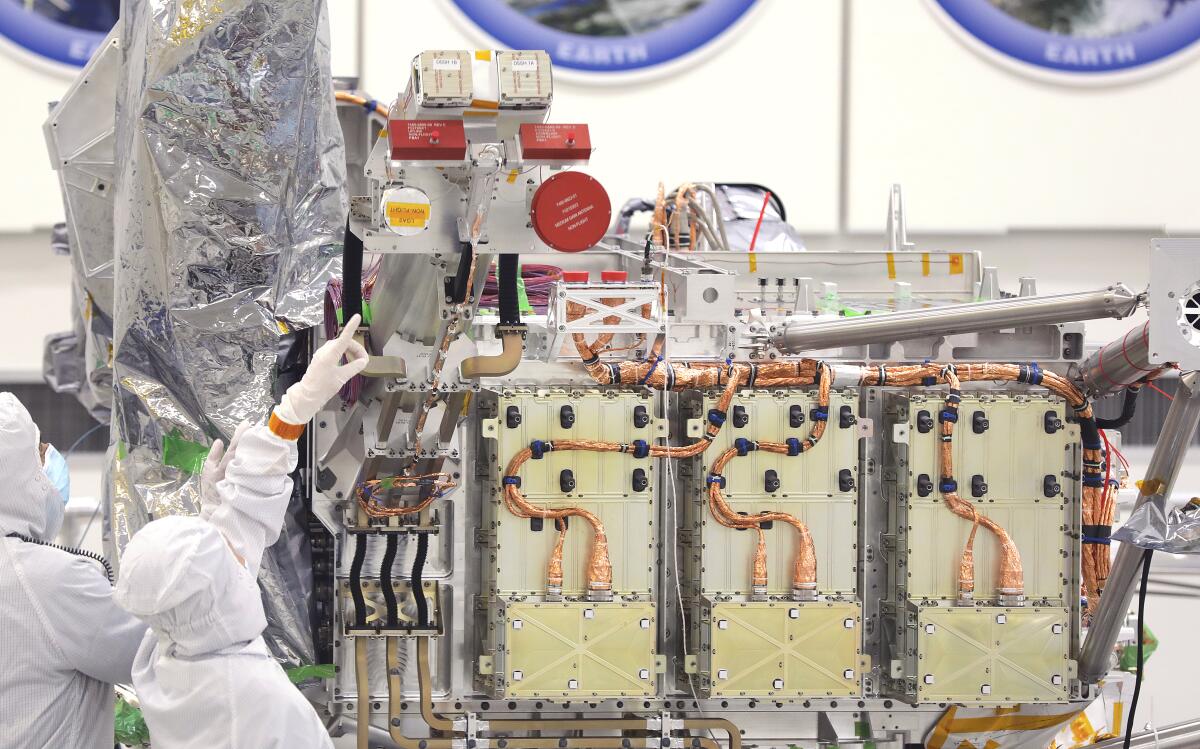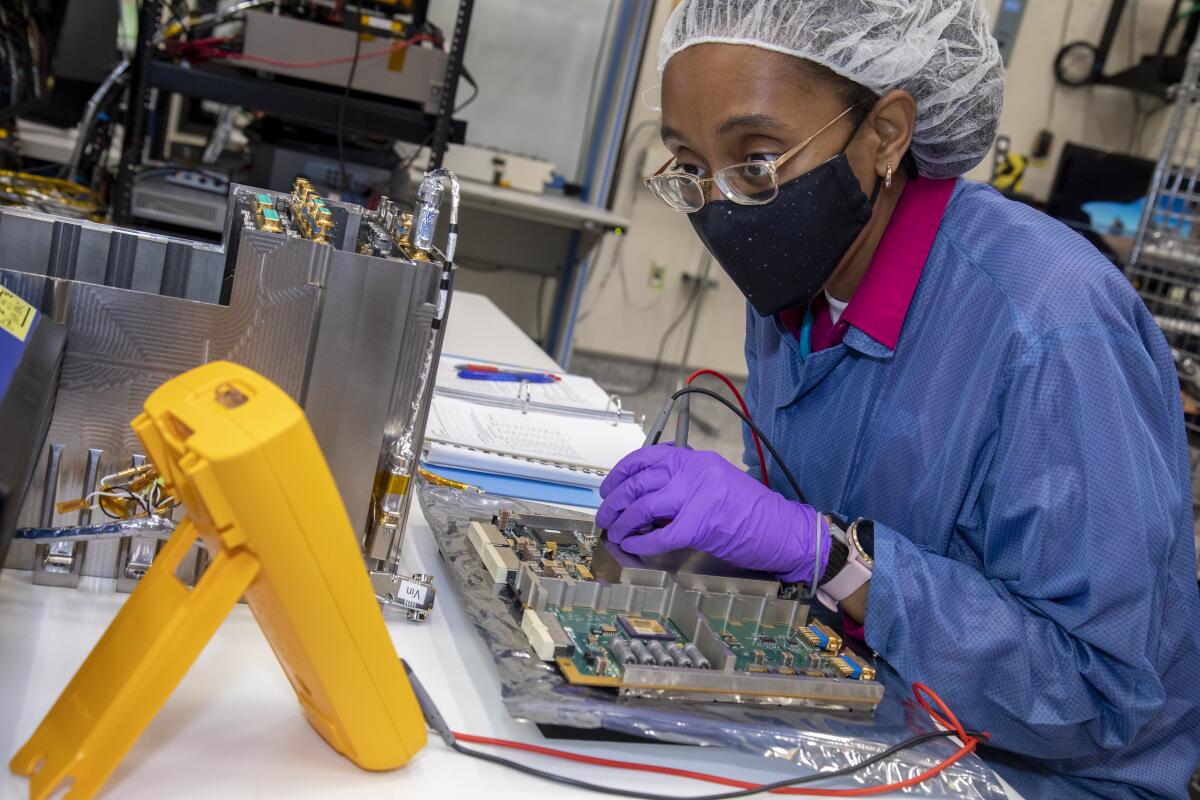How NASA’s Europa Clipper will survive its trip to Jupiter’s hostile moon

- Share via
If life exists elsewhere in the solar system, it may well reside in the ocean of Jupiter’s icy moon Europa.
The mysterious world appears to have the necessary ingredients for life as we know it. Beneath its frozen exterior is a single body of water that’s so deep it may hold more liquid than all of the oceans on Earth. Europa is believed to have enough carbon, hydrogen, nitrogen, oxygen and other key elements to form the building blocks of living organisms. And scientists suspect the heat generated as the moon is stretched and squeezed by Jupiter’s gravity would provide enough energy to sustain any creatures that might be there.
That’s why NASA is building Europa Clipper.

The spacecraft will blast off from the Kennedy Space Center in Florida a year from now and reach its destination in 2030. Once there, it will perform dozens of flybys so its nine dedicated instruments can learn more about Europa’s geology and determine whether it is indeed hospitable to life.
“The ocean makes it one of the best places to look for habitability,” said Cynthia Phillips, a planetary geologist at the Jet Propulsion Laboratory in La Cañada Flintridge and project staff scientist for the $5-billion Europa Clipper mission.
But there’s one major obstacle: Jupiter is home to the harshest known radiation belts in the solar system. The radiation exposure is so high that a person visiting Europa would receive a lethal dose in a matter of hours, according to the European Space Agency. Europa’s delicate instruments are a little hardier than a human, but not by much.
Jupiter’s icy moon Europa squirts water like a squishy bath toy when it’s squeezed by the gas giant’s gravity, scientists say.
That’s why NASA scientists and engineers designed a complex flight path for the spacecraft, with elliptical orbits that will keep it a safe distance from Jupiter’s radiation belts as much as possible. Only one or two days out of Europa Clipper’s two- to three-week orbits will be spent in the most intense radiation zone, dipping in to gather an array of data before retreating to recover.
“On each flyby, it’s like holding your breath,” Phillips said. The spacecraft “will take a deep breath, go in and take all of the pictures and observations, and then get out of there.” Then it will have a week or two to recuperate while the scientists back on Earth examine the data and come up with new commands for the next flyby, she said.

The goal is to execute 45 runs over 2½ years, coming within 16 miles of Europa’s surface. At that distance, Clipper’s magnetometer will be able to measure the depth and salinity of the moon’s ocean; its mass spectrometer will study the ocean’s chemical makeup; and its ultraviolet spectrograph will search for plumes of water vapor escaping through the icy shell.
But even quick flybys aren’t enough to protect the spacecraft’s suite of instruments from Jupiter’s tough radiation environment. So they’ll be encased in custom-made aluminum armor that’s about 1 centimeter thick.
Being bombarded with the high-energy particles that make up Jupiter’s radiation belts is like sitting under an aluminum roof in a hailstorm — it may protect you for a while, but eventually it will sustain too much damage to do its job.
So JPL engineers didn’t try to make armor to deflect the radiation. Instead, they developed a material that absorbs the particles zooming toward the spacecraft and diverts them away from its sensitive interior, protecting both the instruments and any data they’ve collected, said Insoo Jun, co-chair of the Clipper Radiation Focus Group and a member of the Europa Clipper science team.
Is there life on Jupiter’s icy moon Europa? Scientists would like to find out.
Scientists have wanted to get a close look at Europa since the early 1970s, when images from a telescope at Kitt Peak National Observatory in Tucson revealed that the moon’s surface was made of water ice. Visits by NASA’s Voyager 1 and Voyager 2 spacecraft in 1979 suggested the moon was active, and the Galileo mission in 1995 confirmed that Europa had a subsurface ocean, as some scientific models predicted.
Speculation about Europa’s potential habitability also got a boost from a discovery on Earth — an array of unexpected organisms living near magma-fueled hydrothermal vents on the ocean floor.

The data Europa Clipper collects will help scientists determine whether the icy moon really is the prime exobiology candidate they think that it may be.
“This mission is challenging,” Phillips said. “Europa is key to understanding not just the habitability of our own solar system, but potentially expanding the definition of the habitable zone.”
Traditionally, the habitable zone has been thought of as the region around a star where a planet gets the right amount of energy to keep water in liquid form on its surface. Europa is too far away to get that energy from the Sun, but perhaps the push and pull of Jupiter’s gravity can provide it instead.
“If there are habitable environments on Europa,” Phillips said, “that could have profound implications for the probability of life in the cosmos.”







